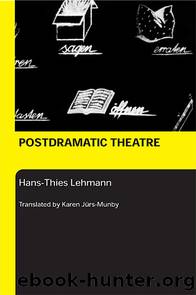Postdramatic Theatre by Lehmann Hans-Thies

Author:Lehmann, Hans-Thies.
Language: eng
Format: epub
Tags: Theatre & Performance Studies
Publisher: Taylor & Francis (CAM)
Published: 2006-02-02T00:00:00+00:00
Examples
1 An evening with Jan and his friends
Like many other contemporary theatre practitioners, the Belgian artist Jan Lauwers thinks of himself not simply as a âdirectorâ but as an âartistâ who among other things also happens to make theatre. In 1980 the âEpigonentheater zlvâ (âzonder leiding vanâ â or âwithout guidance ofâ) was founded in Brussels. Jan Lauwers, one of the initiators, was originally a painter; another co-founder of the collective, André Pichal was a musician. Dancers, too, joined the group. The first performances were Night-illness in 1981, Already Hurt and Not Yet War in 1982, Simonne la puritaine in the same year, the demonstration Vogel Strauss in 1983, Boulevard ZLV in 1984, and Incident in 1985. After the foundation of the Needcompany under the direction of Jan Lauwers, Need To Know, presented in 1988 at the Frankfurter TAT, was the first work that took up classical text (fragments from Shakespeareâs Antony and Cleopatra) in a collage of scenes about love and death. This was followed by Ãa va in 1989, and then in 1990, to the general surprise of critics, by Julius Caesar, a production in which, unlike in the previous works, the text played a dominant role. In 1991 Lauwers showed Invictos based on texts by Ernest Hemingway, especially The Snows of Kilimanjaro (a story in which Hemingway is in turn writing about the writer Scott Fitzgerald), and on E. Hotchnerâs biography Papa Hemingway. As Lauwers confirmed, in his work before Julius Caesar the theatre was based mainly on images. And after Julius Caesar, too, he again sought a non-dramatic text that he could âconstructâ on stage himself, instead of being reduced to the rather dissatisfying role of the director and staging an already created work â which would allow him to do only â50 per cent of the creative workâ. Interviewing him, the journalist Gerhard Fischer expressed his utter surprise at the âconventionalâ, âlinearâ representation in Invictos, at what he saw as the outmoded method of having a narrator.67 But a narrator in the context of the postdramatic aesthetic cannot simply be understood as a traditional epic-literary function. His narrating here manifests the direct contact with the audience.
In this theatre of postepic narration,68 one observes often enough that the action (already fragmented and riddled with other materials anyway) appears only in the form of an account being given: narrated, reported, casually communicated. The extent to which the dramatic has disappeared is especially striking whenever death is being staged in Lauwersâ work. One of the strongest moments of this theatre is when actors who have just died in the fiction, are very calmly led off the stage by fellow players the next moment: a stage life has finished, the actor remains joined to the others in friendship â one of the recurrent motifs in Lauwersâ work. In Hemingwayâs The Snows of Kilimanjaro, a sick man is waiting for his death in the African expanse without resisting it. His leg is gangrenous, the rescue plane is a long time coming, but the man does not want to be rescued anyway.
Download
This site does not store any files on its server. We only index and link to content provided by other sites. Please contact the content providers to delete copyright contents if any and email us, we'll remove relevant links or contents immediately.
| Acting & Auditioning | Broadway & Musicals |
| Circus | Direction & Production |
| History & Criticism | Miming |
| Playwriting | Puppets & Puppetry |
| Stage Lighting | Stagecraft |
Call Me by Your Name by André Aciman(20373)
Ready Player One by Cline Ernest(14525)
How to Be a Bawse: A Guide to Conquering Life by Lilly Singh(7391)
Wiseguy by Nicholas Pileggi(5671)
The Kite Runner by Khaled Hosseini(5083)
On Writing A Memoir of the Craft by Stephen King(4863)
Audition by Ryu Murakami(4850)
The Crown by Robert Lacey(4723)
Call me by your name by Andre Aciman(4619)
Gerald's Game by Stephen King(4582)
Harry Potter and the Cursed Child: The Journey by Harry Potter Theatrical Productions(4440)
Dialogue by Robert McKee(4321)
The Perils of Being Moderately Famous by Soha Ali Khan(4169)
Dynamic Alignment Through Imagery by Eric Franklin(4118)
Apollo 8 by Jeffrey Kluger(3637)
Seriously... I'm Kidding by Ellen DeGeneres(3577)
The Inner Game of Tennis by W. Timothy Gallwey(3575)
How to be Champion: My Autobiography by Sarah Millican(3555)
Darker by E L James(3479)
